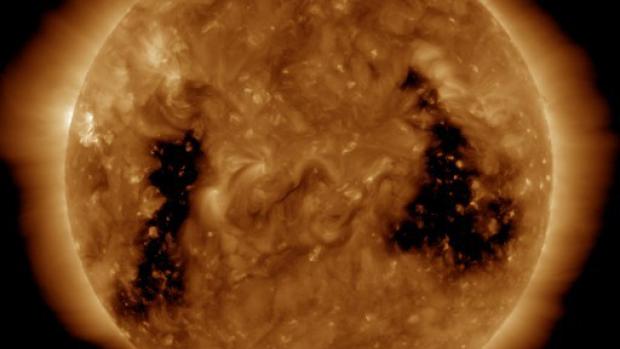
Coronal holes appear as dark areas in the solar corona in extreme ultraviolet (EUV) and soft x-ray solar images. They appear dark because they are cooler, less dense regions than the surrounding plasma and are regions of open, unipolar magnetic fields. This open, magnetic field line structure allows the solar wind to escape more readily into space, resulting in streams of relatively fast solar wind and is often referred to as a high speed stream in the context of analysis of structures in interplanetary space.
Coronal holes can develop at any time and location on the Sun, but are more common and persistent during the years around solar minimum. The more persistent coronal holes can sometimes last through several solar rotations (27-day periods). Coronal holes are most prevalent and stable at the solar north and south poles; but these polar holes can grow and expand to lower solar latitudes. It is also possible for coronal holes to develop in isolation from the polar holes; or for an extension of a polar hole to split off and become an isolated structure. Persistent coronal holes are long-lasting sources for high speed solar wind streams. As the high speed stream interacts with the relatively slower ambient solar wind, a compression region forms, known as a co-rotating interaction region (CIR). From the perspective of a fixed observer in interplanetary space, the CIR will be seen to lead the coronal hole high speed stream (CH HSS).
The CIR can result in particle density enhancement and interplanetary magnetic field (IMF) strength increases preceding onset of the CH HSS. As the CH HSS begins to arrive at Earth, solar wind speed and temperature increase, while particle density begins to decrease. After passage of the CIR and upon transition into the CH HSS flow, the overall IMF strength will normally begin to slowly weaken.
Generally, coronal holes located at or near the solar equator are most likely to result in any CIR passage and/or higher solar wind speeds at Earth. Strong CIRs and the faster CH HSS can impact Earth’s magnetosphere enough to cause periods of geomagnetic storming to the G1-G2 (Minor to Moderate) levels; although rarer cases of stronger storming may also occur. Geomagnetic storms are classified using a five-level NOAA Space Weather Scale. The larger and more expansive coronal holes can often be a source for high solar wind speeds that buffet Earth for many days.
Because of their potential for escalated geomagnetic activity and possible storming (G1 or higher), forecasters analyze coronal holes closely and also note them on the daily synoptic drawing. SWPC forecasters take into account any possible effects of CIR and CH HSS activity when forecasting the anticipated levels of overall planetary geomagnetic response for each 3-hour synoptic period over the next three days; as detailed in the 3-day forecast. Additionally, any predicted CIR or CH HSS influences are explained in more detail in the forecast discussion.
*IMAGE courtesy of NASA